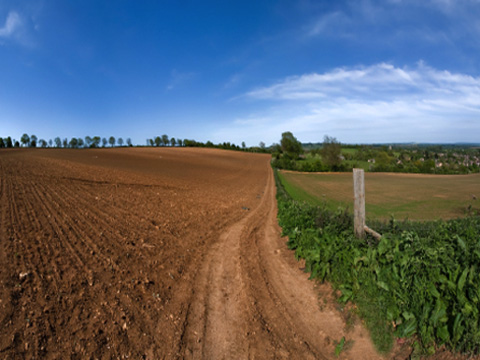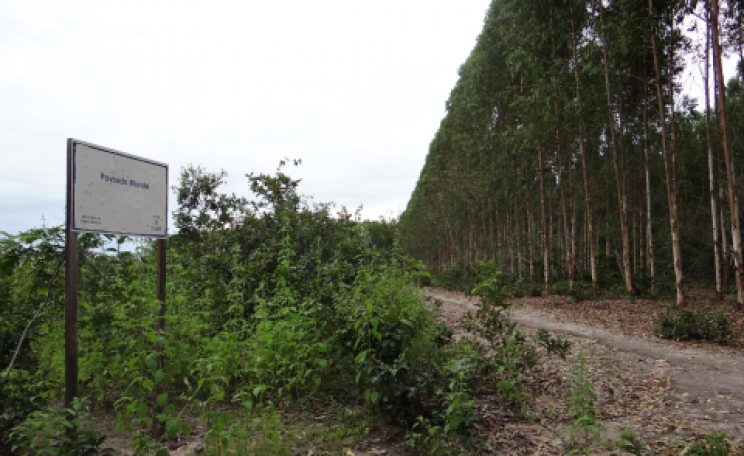Britain's fields of livestock could be replaced by energy crops like Miscanthus
Within 20 years we could - with the right policies and market signals - remove more than 80 per cent of the cattle, cows and sheep that graze in our countryside.
In its place we could grow biomass crops to be used for energy, building materials and industry.
It’s a revolutionary vision that would completely change both the look and outlook of our countryside. It may also change the look of our cities if people start to take a renewed interest in backyard poultry and pig-rearing to meet desires for meat.
But beyond the aesthetics of removing fields of dotted sheep and cattle, the new biomass-producing countryside as outlined in a groundbreaking report from the Centre of Alternative Technology (CAT), could also play a role in significantly reducing the UK’s carbon emissions.
Grazing domination
At present, 70-80 per cent of the UK’s land is used either for grazing livestock or growing feed for it. In the CAT vision grazing grassland would instead be planted with nutritionally-equivalent food crops and perennial crops like miscanthus and short rotation coppice.
Replacing livestock with food crops would reduce greenhouse gas emissions by 60-70 per cent but also leave lots of spare, unused land that could be used to grow the biomass crops.
The benefit of biomass is two-fold: it can be used to produce non-fossil fuel energy in the form of woodchips that can produce heat or electricity; or the carbon it takes up during growth can be sequestered by leaving it as woodland, using it in building materials or converting it to charcoal or biochar (a biologically stable form of carbon).
There are even suggestions that this biochar could be buried deep in the ocean in a form of carbon capture and storage.
Aside from the energy sector, perhaps the biggest beneficiary of the rapid increase in biomass would be the building industry – with nearly 40 million tones of material available every year for developers. This would sequester £47m tonnes of CO2 a year and additionally help to offset the emissions of remaining livestock sector.
Better returns for farmers?
So what’s stopping biomass? Many UK farmers are reluctant to grow wood crops because of poor returns in comparison to wheat or oilseeds.
CAT believes a significantly higher carbon price - perhaps as much as £500 per tonne of CO2 by 2030, far in excess of current government predictions of £70 per tonne - would make growing biomass crops more financially attractive. Fertiliser prices, the largest single variable input cost for most crops in the UK, would increase in price, making relatively fertiliser non-intensive biomass crops, such as Miscanthus, more attractive to farmers.
In fact many livestock farmers may already be better off switching to growing energy crops. Two studies commissioned by the National Non-Food Crops Centre (NNFCC) concluded that biomass offered the potential for long-term stable returns to beef and sheep farmers in particular.
'Perennial energy crops require fewer inputs such as fuel and fertiliser and so costs are also more predictable. For farmers seeking stability perennial energy crops may be more attractive than the more volatile grains and oilseeds as long as a reasonable minimum income level can be achieved,' concluded a report from the Scottish Agricultural College (SAC).
Factory farming
However, the debate about biomass does not just revolve around markets. The Soil Association argues that CAT’s vision promotes intensive pig and poultry farming methods at the expense of grazing livestock, which it says sequesters large amounts of carbon in the soil.
While sheep, beef and dairy numbers would be cut by 80-90 per cent, the non-grazing pig (20 per cent cut) and poultry sectors (no cut in eggs, 50 per cent cut in chicken meat), which CAT says have ‘lower carbon-intensities’, would see smaller reductions.
‘Acre for acre grazing livestock produce more greenhouse gas emissions along with less nutritional value than other animals or crops,’ say CAT, adding it would be ‘impossible’ to reduce Britain’s emissions to zero without a reduction in red meat production and consumption.
No mention is made of avoiding the factory-farming approaches synonymous with the pig and poultry sector, and CAT remains ambivalent about organic methods of farming.
‘We’d prefer to be organic but we can’t make the sums add up. If you go organic, emissions tend to go up a bit,’ says Peter Harper, head of research and innovation at CAT.
The Soil Association is among those who have argued that unlike factory-reared pig and poultry, grazing grass-fed livestock do not rely on imported animal feed, which in the case of soya from Brazil may be contributing towards deforestation.
Soil degradation
Others go further and suggest switching from grazing grasslands to crops will also lead to soil degradation.
‘When we burn Miscanthus or other energy crops, we asset strip the earth for a small return of utterly non-renewable energy,’ argues Patrick Noble, an organic farmer and author from Wales, who has published his criticisms through the campaign group, the Institute of Science in Society. He says growing biomass would destroy soil fertility.
‘Until very recently farm tenancy agreements would have clauses forbidding the sale of hay, or straw. Selling them reduced the value of a farm, by exporting its fertility. You can’t keep growing crops without putting it back. It is impossible to farm like this. You’ll get a lower yield each year. You will be losing carbon and reducing it in the soil.
‘I don’t think it is as easy as CAT suggests,' he says. 'We’ve got a struggle to meet food and energy needs.'
Harper from CAT admits that initially the wood crops would require fertiliser inputs in the first stages of growth but would put carbon and fertility back into the soil over time, with 20 per cent of the biomass going back into the soil in the form of leaves and the roots.
‘What do we do at the moment with these fields? Send cows to eat them so we are already doing it [exporting fertility]. What we are proposing is exactly the same except the product is different. The cost is less meat but you don’t have to get forage for the animals now. Arable land should be given to grow directly for human consumption; the grazing land for biomass,’ he says.
‘The area of land suitable for these types of crops is pretty much everywhere except big mountains and cities. Perennial crops are available for every type of land. We just don’t know the yields in every place,’ says Harper.
Time for a new landscape
Harper acknowledges the benefits of grazing but says perennial crops can also sequester carbon. In any case, he argues, the calculations do not include the emissions from the livestock. He says if the UK is serious about reducing its emissions that it will have to accept a radically different landscape to the one we have grown up with.
‘Every generation gets used to what the countryside looked like when they were children and at least 50 per cent was used for horses 100 years ago, as the main form of transport.
‘If you’ve got a big target for cutting emissions as we do have with 80 per cent by 2050 then you’ve got to ask yourself whether we seriously mean to get there. The real answer is no. But we think they should be taken seriously and have constructed a scenario that is physically possible.'
Useful links
Zero carbon Britain report
Scottish Agricultural College (SAC) report on impact of biomass
NNFCC commissioned report on land-use issues from increasing biomass

| READ MORE... | |
 |
NEWS ANALYSIS Have we got it right on meat and greenhouse gas emissions? Analysis showing lower greenhouse gas emissions associated with intensive livestock production could pose a challenge to our views on best farming practice |
 |
LETTER Letter: grazing pasture is a net carbon sink The article, 'Have we got it right on meat and greenhouse gas emissions?' misses an important point made at the Oxford Real Farming Conference, which is that properly managed pasture is a net carbon sink |
 |
INVESTIGATION Can cows help stop climate change? Meat, dairy... in fact, livestock in general has in recent years joined the ranks of the 4x4 and the short-haul flight. But could a change in the way we graze animals not only reduce greenhouse gas emissions, but even remove them from the atmosphere? |
 |
NEWS ANALYSIS Change farming to cut CO2 emissions by 25 per cent A new report has revealed that a change in the way we manage agricultural land could help sequester a quarter of the world's carbon dioxide emissions every year |







